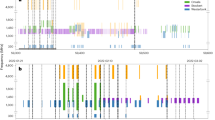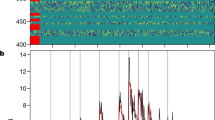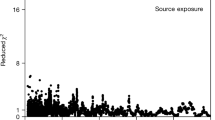Abstract
Fast radio bursts are millisecond-duration astronomical radio pulses of unknown physical origin that appear to come from extragalactic distances1,2,3,4,5,6,7,8. Previous follow-up observations have failed to find additional bursts at the same dispersion measure (that is, the integrated column density of free electrons between source and telescope) and sky position as the original detections9. The apparent non-repeating nature of these bursts has led to the suggestion that they originate in cataclysmic events10. Here we report observations of ten additional bursts from the direction of the fast radio burst FRB 121102. These bursts have dispersion measures and sky positions consistent with the original burst4. This unambiguously identifies FRB 121102 as repeating and demonstrates that its source survives the energetic events that cause the bursts. Additionally, the bursts from FRB 121102 show a wide range of spectral shapes that appear to be predominantly intrinsic to the source and which vary on timescales of minutes or less. Although there may be multiple physical origins for the population of fast radio bursts, these repeat bursts with high dispersion measure and variable spectra specifically seen from the direction of FRB 121102 support an origin in a young, highly magnetized, extragalactic neutron star11,12.
This is a preview of subscription content, access via your institution
Access options
Subscribe to this journal
Receive 51 print issues and online access
$199.00 per year
only $3.90 per issue
Buy this article
- Purchase on Springer Link
- Instant access to full article PDF
Prices may be subject to local taxes which are calculated during checkout


Similar content being viewed by others
References
Lorimer, D. R., Bailes, M., McLaughlin, M. A., Narkevic, D. J. & Crawford, F. A bright millisecond radio burst of extragalactic origin. Science 318, 777–780 (2007)
Thornton, D. et al. A population of fast radio bursts at cosmological distances. Science 341, 53–56 (2013)
Burke-Spolaor, S. & Bannister, K. W. The Galactic position dependence of fast radio bursts and the discovery of FRB 011025. Astrophys. J. 792, 19 (2014)
Spitler, L. G. et al. Fast radio burst discovered in the Arecibo Pulsar ALFA survey. Astrophys. J. 790, 101 (2014)
Petroff, E. et al. A real-time fast radio burst: polarization detection and multiwavelength follow-up. Mon. Not. R. Astron. Soc. 447, 246–255 (2015)
Ravi, V., Shannon, R. M. & Jameson, A. A fast radio burst in the direction of the Carina dwarf spheroidal galaxy. Astrophys. J. 799, L5 (2015)
Champion, D. J. et al. Five new fast radio bursts from the HTRU high latitude survey: first evidence for two-component bursts. Preprint at http://arxiv.org/abs/1511.07746 (2015)
Masui, K. et al. Dense magnetized plasma associated with a fast radio burst. Nature 528, 523–525 (2015)
Petroff, E. et al. A survey of FRB fields: limits on repeatability. Mon. Not. R. Astron. Soc. 454, 457–462 (2015)
Falcke, H. & Rezzolla, L. Fast radio bursts: the last sign of supramassive neutron stars. Astron. Astrophys. 562, A137 (2014)
Cordes, J. M. & Wasserman, I. Supergiant pulses from extragalactic neutron stars. Mon. Not. R. Astron. Soc. 457, 232–257 (2016)
Pen, U.-L. & Connor, L. Local circumnuclear magnetar solution to extragalactic fast radio bursts. Astrophys. J. 807, 179 (2015)
Cordes, J. M. et al. Arecibo pulsar survey using ALFA. I. Survey strategy and first discoveries. Astrophys. J. 637, 446–455 (2006)
Lazarus, P. et al. Arecibo pulsar survey using ALFA. IV. Mock spectrometer data analysis, survey sensitivity, and the discovery of 40 pulsars. Astrophys. J. 812, 81 (2015)
Cordes, J. M. & Lazio, T. J. W. NE 2001.I. A new model for the galactic distribution of free electrons and its fluctuations. Preprint at http://arxiv.org/abs/astro-ph/0207156 (2002)
Ransom, S. M. New Search Techniques for Binary Pulsars. http://www.cv.nrao.edu/~sransom/ransom_thesis_2001.pdf, PhD thesis, Harvard Univ. (2001)
Karako-Argaman, C. et al. Discovery and follow-up of rotating radio transients with the Green Bank and LOFAR telescopes. Astrophys. J. 809, 67 (2015)
Wolszczan, A. & Cordes, J. M. Interstellar interferometry of the pulsar PSR 1237+25. Astrophys. J. 320, L35–L39 (1987)
Kulkarni, S. R., Ofek, E. O. & Neill, J. D. The Arecibo fast radio burst: dense circum-burst medium. Preprint at http://arxiv.org/abs/1511.09137 (2015)
Camilo, F. et al. Transient pulsed radio emission from a magnetar. Nature 442, 892–895 (2006)
Hansen, B. M. S. & Lyutikov, M. Radio and X-ray signatures of merging neutron stars. Mon. Not. R. Astron. Soc. 322, 695–701 (2001)
Loeb, A., Shvartzvald, Y. & Maoz, D. Fast radio bursts may originate from nearby flaring stars. Mon. Not. R. Astron. Soc. 439, L46–L50 (2014)
Mottez, F. & Zarka, P. Radio emissions from pulsar companions: a refutable explanation for galactic transients and fast radio bursts. Astron. Astrophys. 569, A86 (2014)
Lyubarsky, Y. A model for fast extragalactic radio bursts. Mon. Not. R. Astron. Soc. 442, L9–L13 (2014)
Karuppusamy, R., Stappers, B. W. & van Straten, W. Giant pulses from the Crab pulsar. A wide-band study. Astron. Astrophys. 515, A36 (2010)
Hankins, T. H. & Eilek, J. A. Radio emission signatures in the Crab pulsar. Astrophys. J. 670, 693–701 (2007)
Keane, E. F., Stappers, B. W., Kramer, M. & Lyne, A. G. On the origin of a highly dispersed coherent radio burst. Mon. Not. R. Astron. Soc. 425, L71–L75 (2012)
Bannister, K. W. & Madsen, G. J. A Galactic origin for the fast radio burst FRB010621. Mon. Not. R. Astron. Soc. 440, 353–358 (2014)
Scholz, P. et al. Timing of five millisecond pulsars discovered in the PALFA survey. Astrophys. J. 805, 85 (2015)
Theureau, G. et al. PSRs J0248+6021 and J2240+5832: young pulsars in the northern Galactic plane. Discovery, timing, and gamma-ray observations. Astron. Astrophys. 525, A94 (2011)
McLaughlin, M. A. et al. Transient radio bursts from rotating neutron stars. Nature 439, 817–820 (2006)
You, X. P., Coles, W. A., Hobbs, G. B. & Manchester, R. N. Measurement of the electron density and magnetic field of the solar wind using millisecond pulsars. Mon. Not. R. Astron. Soc. 422, 1160–1165 (2012)
The NANOGrav Collaboration. The NANOGrav nine-year data set: observations, arrival time measurements, and analysis of 37 millisecond pulsars. Astrophys. J. 813, 65 (2015)
Rickett, B. J. Radio propagation through the turbulent interstellar plasma. Annu. Rev. Astron. Astrophys. 28, 561–605 (1990)
Acknowledgements
We thank the staff of the Arecibo Observatory, and in particular A. Venkataraman, H. Hernandez, P. Perillat and J. Schmelz, for their continued support and dedication to enabling observations like those presented here. We also thank our commensal observing partners from the Arecibo ‘Zone of Avoidance’ team, in particular T. McIntyre and T. Henning. We thank M. Kramer for suggestions. The Arecibo Observatory is operated by SRI International under a cooperative agreement with the National Science Foundation (AST-1100968), and in alliance with Ana G. Méndez-Universidad Metropolitana, and the Universities Space Research Association. These data were processed using the McGill University High Performance Computing Centre operated by Compute Canada and Calcul Québec. The National Radio Astronomy Observatory is a facility of the National Science Foundation operated under cooperative agreement by Associated Universities, Inc. The research leading to these results has received funding from the European Research Council (ERC) under the European Union’s Seventh Framework Programme (FP7/2007-2013). L.G.S., P.C.C.F. and P.L. gratefully acknowledge financial support from the ERC Starting Grant BEACON under contract number 279702. J.W.T.H. is an NWO Vidi Fellow and gratefully acknowledges funding for this work from ERC Starting Grant DRAGNET under contract number 337062. Work at Cornell (J.M.C., S.C., A.B.) was supported by NSF grants AST-1104617 and AST-1008213. V.M.K. holds the Lorne Trottier Chair in Astrophysics and Cosmology and a Canadian Research Chair in Observational Astrophysics and received additional support from NSERC via a Discovery Grant and Accelerator Supplement, by FQRNT via the Centre de Recherche Astrophysique de Québec, and by the Canadian Institute for Advanced Research. J.v.L. acknowledges funding for this research from an ERC Consolidator Grant under contract number 617199. Pulsar research at UBC is supported by an NSERC Discovery Grant and by the Canadian Institute for Advanced Research.
Author information
Authors and Affiliations
Contributions
L.G.S. and J.W.T.H. led the design and execution of the observing campaign described here. P.S. performed the analysis that discovered the radio bursts. More detailed analysis of the signal properties was done by L.G.S., P.S., S.M.R., M.A.M., J.W.T.H., S.C. and J.M.C. L.G.S., J.W.T.H., P.S. and V.M.K. led the writing of the manuscript. All authors contributed substantially to the interpretation of the analysis results and to the final version of the manuscript.
Corresponding author
Ethics declarations
Competing interests
The authors declare no competing financial interests.
Extended data figures and tables
PowerPoint slides
Source data
Rights and permissions
About this article
Cite this article
Spitler, L., Scholz, P., Hessels, J. et al. A repeating fast radio burst. Nature 531, 202–205 (2016). https://doi.org/10.1038/nature17168
Received:
Accepted:
Published:
Issue Date:
DOI: https://doi.org/10.1038/nature17168
Comments
By submitting a comment you agree to abide by our Terms and Community Guidelines. If you find something abusive or that does not comply with our terms or guidelines please flag it as inappropriate.



